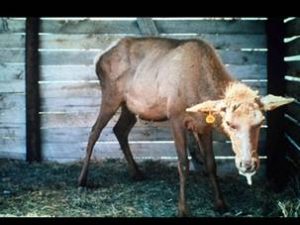In March, 1996, the UK government confirmed what had been known for years: bovine spongiform encephalopathy (or mad cow disease) was killing humans in the UK.
 The various forms of transmissible encephalopathies have different names according to the species – scrapie in sheep, feline spongiform encephalopathy in cats, Creutzfeldt-Jacob disease in humans, chronic wasting disease in deer and elk.
The various forms of transmissible encephalopathies have different names according to the species – scrapie in sheep, feline spongiform encephalopathy in cats, Creutzfeldt-Jacob disease in humans, chronic wasting disease in deer and elk.
But they’re all the same affliction, caused by infectious proteins, or prions.
I haven’t been following the CWD outbreak in deer, but it seems to be where BSE was about 1993: There’s this mysterious new disease no one ever thoughts would cross over to humans, but now, maybe?
Jim Robbins of the New York Times writes that, as darkness closed in, one hunter after another stopped at this newly opened game check station, deer carcasses loaded in the beds of their pickups.
They had been given licenses for a special hunt, and others would follow. Jessica Goosmann, a wildlife technician with Montana’s Fish, Wildlife & Parks Department, stepped outside to greet them, reaching for the neck of each freshly killed deer to cut an incision and remove a lymph node for testing.
On the edge of this south-central Montana village, where deer hunting is a way of life, the game check station has become the front line of the state’s efforts to stop the spread of a deadly infection known as chronic wasting disease.
 It has ravaged deer herds throughout the United States and Canada and forced the killing of thousands of infected animals in 24 states and three Canadian provinces. It has also been found in Norway and South Korea. With the disease widespread in Wyoming, the Dakotas and the province of Alberta, Montana officials had been bracing for its emergence.
It has ravaged deer herds throughout the United States and Canada and forced the killing of thousands of infected animals in 24 states and three Canadian provinces. It has also been found in Norway and South Korea. With the disease widespread in Wyoming, the Dakotas and the province of Alberta, Montana officials had been bracing for its emergence.
So in November, when biologists discovered it in six deer in this part of Montana and in another near the Canadian border, officials began setting up special hunts and stations for testing.
“It wasn’t a surprise that we found it,” said John Vore, game management bureau chief for the Montana Department of Fish, Wildlife & Parks. “It was a disappointment, but not a surprise.”
On Friday, the department announced that two more deer from this region, taken early in the special hunt, tested positive for the disease. Other test results are pending.
Chronic wasting disease is a contagious neurological disease that infects elk, deer, moose and caribou, and reduces their brains to a spongy consistency. Animals become emaciated, behave strangely and eventually die. It’s not known to be transferred to humans. Neither is it known to be spread from wild to domestic animals. There is no treatment, although a vaccine has been successful in tests in wild deer.
It is among a class of diseases known as transmissible spongiform encephalopathy, or TSE. Most experts believe the infectious agent is something called a prion, a misfolded cellular protein found in the nervous system and lymph tissue. The disease was first noted in captive deer in Colorado in the 1960s. The most closely related animal disease is scrapie in sheep.
“It’s a very unusual disease,” said Matthew Dunfee, an expert at the Wildlife Management Institute in Fort Collins, Co. and project director for the Chronic Wasting Disease Alliance. “Some experts say it’s a disease from outer space.”
